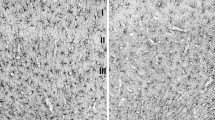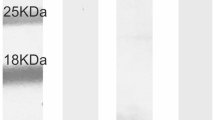Abstract
The present paper is the first comprehensive study on the astroglia of a teleost fish that is based on the immunohistochemical staining of GFAP (glial fibrillary acidic protein, an immunohistochemical marker of astroglia). The ray-finned fishes (Actinopterygii) and their largest group, the Teleostei, represent a separate pathway of vertebrate evolution. Their brain has a very complex macroscopic structure; several parts either have no equivalents in tetrapods or have a very different shape, e.g., the telencephalon. The results show that the teleost brain has a varied and highly specialized astroglial architecture. The primary system is made up of radial glia, which are of ependymal origin and cover the pial surface with endfeet. The tendency is, however, that the more caudal a brain area is, the less regular is the radial arrangement. A typical radial glia dominates some parts of the diencephalon (median eminence, lobus inferior and habenula) and the telencephalon. In the rest of the diencephalon and in the mesencephalon, the course of the glial fibers is modified by brain tracts. The most specialized areas of the teleost brain, the optic tectum and the cerebellum, display elaborate variations of the original radial system, which is adapted to their layered organization. In the cerebellum, an equivalent of the Bergmann-glia can be found, although its fiber arrangement shows meaningful differences from that of mammals or birds. In the lower brain stem radial glia are confined to fibers separating the brain tracts and forming the midline raphe. A dense ependymoglial plexus covers the inner surface of the tectum and the bottom of the rhombencephalic ventricle, intruding into the vagal and facial lobes. The structure and the position of the rhombencephalic plexus suggest that it corresponds to a circumventricular organ that entirely occupies the bottom of the ventricle. Perivascular glia show an unusual form as they consist of long fibers running along the blood vessels. In the large brain tracts long glial fibers run parallel with the course of the neural fibers. At least in the diencephalon, these glial fibers seem to be modified radial fibers. Real astrocytes (i.e., stellate-shaped cells) can be found only in the brain stem and even there only rarely. The glial specialization in the various areas of the teleost brain seems to be more elaborate than that found either in amphibia or in reptiles.
Similar content being viewed by others
Author information
Authors and Affiliations
Additional information
Accepted: 15 May 1998
Rights and permissions
About this article
Cite this article
Kálmán, M. Astroglial architecture of the carp (Cyprinus carpio) brain as revealed by immunohistochemical staining against glial fibrillary acidic protein (GFAP). Anat Embryol 198, 409–433 (1998). https://doi.org/10.1007/s004290050193
Issue Date:
DOI: https://doi.org/10.1007/s004290050193




